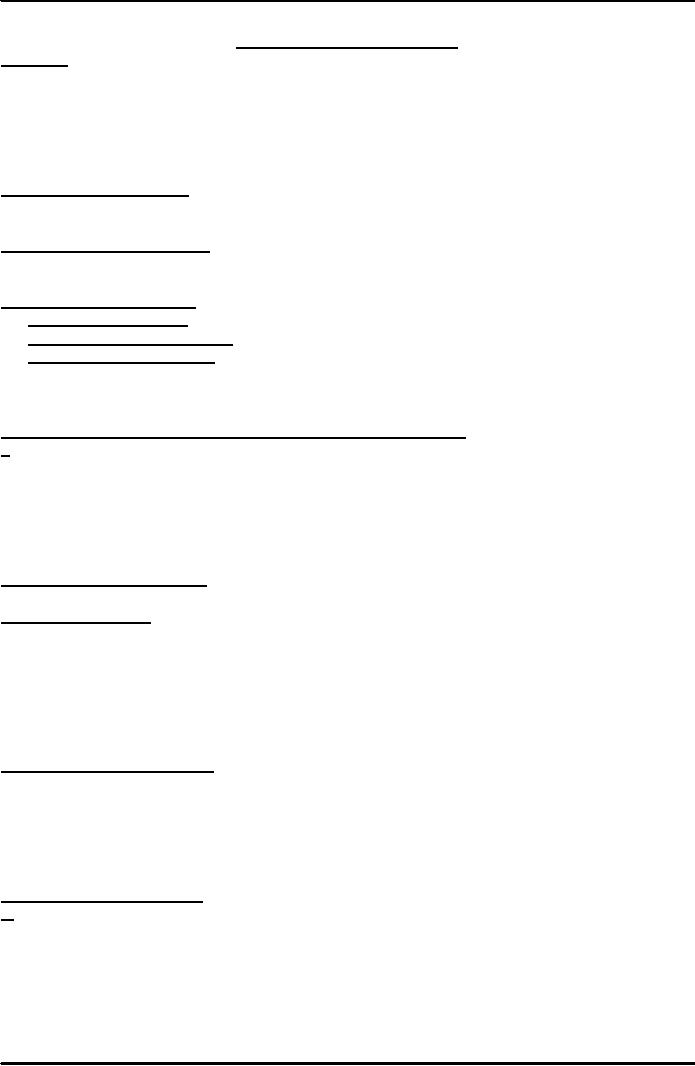 |
PUBLIC RELATIONS & LAW:How To Stay Out Of Trouble |
| << COMMUNICATION CONCEPTS & THEORIES:Research and Persuasion |
| PUBLIC RELATIONS & CASE STUDIES:Case Analysis, Images Of Public Relations >> |

Fundamentals
of Public Relations MCM 401
VU
Lesson
37
PUBLIC
RELATIONS & LAW
Overview
With
the increased awareness of ones rights
and the democratic principles and
practices in place it is
important
to know the legal implications in the use
of public relations plans and
strategies. The students
will
also
be acquainted with important
methods to stay out of
trouble. We will also
explain various
repercussions
and implications of libel, slander
and defamation. We will also
discuss regarding
public
relations
role in legal
matters.
As
Samuel Johnson
opined
"The
law is the last result of
human wisdom acting upon
human experience for the
benefit of public."
Francis
Maitland Balfour said
"
Law: a mousetrap easy to enter,
but not easy to get
out of."
Liabilities
Of Practicing PR
1.
Normal
legal exposure, like
encountered by any other
person.
2.
Work
oriented legal exposure such
as found in the course of normal PR or
publicity activities.
3.
Extraneous
legal exposure including
everything from testifying as an expert
witness to getting sports
event
tickets for a client, to lobbying
without registering as a lobbyist or
reporting income and
expenses
from
such activities.
Legal
Problems: Civil & Criminal
According
to Morton Simons
5
situations
where PR practitioner may be
subjected to legal implications.
1.
Participates in the illegal action.
2.
Counsels, guides & directs the
policy behind it.
3.
Takes a large personal part
in it.
4.
Sets up a propaganda agency to
fight enemies of it.
5.
Cooperates to further
it.
How
To Stay Out Of
Trouble
Best
way to stay out of trouble
is to maintain good relationship with the attorney of
the organization...!
5
ways can be helpful
1.
Recognize
your individual responsibility for
your action.
2.
Know
your business.
3.
Ignore
the vague lines between advertising &
PR, because the law often
does.
4.
Decide
how far you are
willing to go to run a risk of jail
,fine, a cease or desist
order or a corrective
order.
5.
"Know
your enemy" specially which
Government agency is likely to go after
you.
5
Good Points For PR
Persons
1.
Be
careful about headlines &
pictures.
2.
Carefully
select every word, even the
smallest one.
3.
Use
numbers where essential or
important.
4.
Be
aware about the ingredients behind the
product.
5.
Only
repeat a slogan where
necessary.
Defamation:
Libel & Slander
2
Kinds of Libel: Civil &
Criminal
Libel:
"written
or otherwise published defamation"
Slander:
"spoken defamation".
Civil
Libel: this is
non criminal such as malicious
publication tending to tarnish the
reputation of a living
person...
Injuring his repute.
Criminal
Libel:
breach of peace or treason
--- involves inciting to
riot or some other form of
violence
against
the government.
89

Fundamentals
of Public Relations MCM 401
VU
Defense
Against Libel Basically Three
(3)
1.
Truth:
substantial
proof that is admissible in
court.
2.
Privilege:
a fair
and true report of a public,
official or judicial
proceeding.
3.
Fair
Comment: statements
made in an honest belief
that they are true.
Rights
of Privacy
Rights
of privacy apply only to people, and
not to organizations..
4
types of violations
1.
Intrusion into solitude.
2.
Portraying someone in a false
light.
3.
Public disclosure of private
information.
4.
Appropriation. Using a person's name or
likeness for commercial
purposes without person's
consent. In
fact
it is the privacy violation that causes
most PR problems.
Contracts
& Consents
Normally
PR practitioner should not get
involved in contracts
etc.
Should
know about at least 5 such
forms:
1.
Model
Release. When
models are required for some
campaign etc.
2.
Employee
Contract.
Basically job related
contracts.
3.
Photo
Agreement.
Rights to release and use
pictures for particular
events.
4.
Work
For Hire. To
hire personnel for some
project etc.
5.
Printing
Contract.
Contracts for getting some
printing jobs to be carried
out by printer etc.
90
Table of Contents:
- INTRODUCTION & BRIEF HISTORY:Definitions Of Public Relations
- HOW DOES PR WORK?:OVERVIEW, Formulation of policy
- PUBLIC RELATIONS DISTINGUISHED:Size of a PR Department.
- PUBLICS OF PR:Expanded Publics, Few Examples Of Publics
- PLANNING PUBLIC RELATIONS PROGRAMMES:Print Media, Electronic Media
- MEDIAS OF PR:Media for External Publics, Principles of Good Press Relations
- PRESS RELATIONS IN PR:What is News, Secrets Of Good News Release.
- CREATED PRIVATE MEDIA:Private Media, New Forms of House Journals
- SPECIAL USES OF PUBLIC RELATIONS:Crisis Management, Skills Of PR
- BUDGETING IN PR:Labour, Office Overheads, PR & Photographs
- PUBLIC RELATIONS PROBLEMS:Defining PR problems, C’s of PR explained
- METHODS OF COMMUNICATION:Psychology of Public Relations
- PR IN VARIOUS ORGANIZATIONS:Techniques of Trade Association PR
- PR IN LABOUR UNIONS & RELIGIOUS GROUPS:Community Public Relations
- PR IN EDUCATIONAL INSTITUTIONS & IN MEDIA CHANNALS
- USING ADVERTISING FOR P R COMMUNICATION:Role Of PR
- ROLE OF PUBLIC RELATIONS IN MARKETING:How To Educate The Market
- PUBLIC RELATIONS AND CORPORATE STRUCTURE:Corporate Identity Essentials
- E-PR & ITS TOOLS:Immediate Points To Consider, Using Email As PR Tool
- SPONSORSHIP—AN IMPORTANT PR TOOL:PR & Communication Audit
- HOUSE JOURNALS:Possible Publics Of House Journals, Exhibitions & PR
- CRISIS MANAGEMENT IN PR:Plan Of Action Adopted, Interview at your place
- ADVERTISING IN PR:Broad Objectives Of Advertising, Direct Advertising.
- INTERNATIONAL PUBLIC RELATIONS:Media Used, Within Store Contacts
- PUBLIC RELATIONS CONSULTANCY:Disadvantages, Mass Communication
- PUBLIC RELATION’S ROLE IN MARKET EDUCATION:Kinds Of Markets
- MODERN DAY VALUES OF PR:Ethics Of Public Relations
- CHOICE OF MEDIA FOR PR COMPAIGN:Communication Channels & Media
- PR TECHNIQUES:Tactics & Techniques
- DESIGNING PR COMPAIGNS:Definitive Mission statement, Reputation.
- PUBLIC OPINION:Identifying Priority Publics, If Goal Is Attitude Change
- PUBLIC RELATIONS AND RESEARCH:Planning Phase Of Research
- PR AND RESEARCH:Unobtrusive Measures, Questionnaires For Survey
- PROBLEMS SOLVING STRATEGIES:Communicate results
- PERSUASION & COMMUNICATION THEORIES:Message Orientation
- COMMUNICATION CONCEPTS & THEORIES:Research and Persuasion
- PUBLIC RELATIONS & LAW:How To Stay Out Of Trouble
- PUBLIC RELATIONS & CASE STUDIES:Case Analysis, Images Of Public Relations
- PR AND PRINTING PROCESSES:Fundamentals Of Printing
- PUBLIC SPEAKING -- A PR TOOL:Key Benefits, How To Prepare
- PR -- COPING WITH UNEXPECTED:Some Possible PR Ideas
- DREAMS & REALITIES OF PR:Who Takes Charge Of Identity?
- CHANGING INTO OVERDRIVE:How International Is PR?
- GETTING ON WITH PR:Where does PR fit in the structure?
- FUNDAMENTALS OF A SUCCESSFUL NEWSLETTER:RESEARCH, WRITING